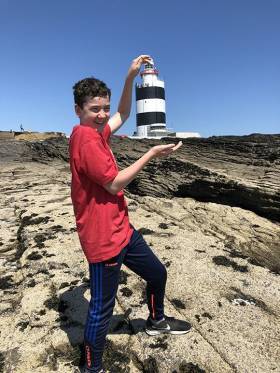Displaying items by tag: Photo Competition
The Sun is Shining and We have a Winner! - ‘Great Lighthouse, Great Fun’ Photography Competition
#Lighthouses - It is more than eight weeks ago when Bobby Kerr, Chair of Great Lighthouses of Ireland helped kick off summer in fine style when he announced the ‘Great Lighthouse, Great Fun’ photography competition.
The competition was held to invite all to discover the amazing coastlines of Ireland, the challenge was simple: take a photograph that best captures and expresses the best of summer fun at a lighthouse.
“We had a huge number of entries, all a fantastic reflection of Ireland in summer... it was a challenging task for our judges to select (a) final ten, then five and (lastly) the winner,“ Kerr said.
“The winning image of Gar Heffernan holding Hook (Lighthouse) in his hands captured the essence of summer fun at our lighthouses. Well done, Gar. We look forward to meeting you,” said Kerr.
Gar and his family will enjoy a fantastic bespoke Great Lighthouses of Ireland experience for four people, which will include:
- A two-night stay at any of the Great Lighthouses of Ireland self-catering houses
- A personal tour with our leading storykeeper at any of our lighthouse attractions
- A unique opportunity to meet the Irish Lights historian at Howth’s Baily Lighthouse to learn all about the history and heritage of Irish Lights
- A chance to meet the Irish Lights team and learn more about how navigational aids work today
Speaking from SeaFest, Galway, Yvonne Shields, Chief Executive of Irish Lights said: “We look forward to welcoming our ‘Great Lighthouse, Great Fun’ winner and guests to Irish Lights to see the work involved in ensuring safe navigation around the coast of Ireland and (to) meet the team, whose technical and engineering expertise contributes to the development of our maritime economy. This weekend, we encourage all to come on board the Granualie at Seafest.” (See related ships on show tours).
Great Lighthouses of Ireland is an exciting collaboration between many private and public organisations in coastal communities, led and supported by Irish Lights. For event details and information about and booking Great Lighthouses of Ireland, see: www.greatlighthouses.com/shine-a-light
Twitter: @gtlighthouses | https://twitter.com/gtlighthouses
Facebook: @greatlighthousesofireland | https://www.facebook.com/greatlighthousesofireland
For full details and the competition terms and conditions, click this link here.
























































